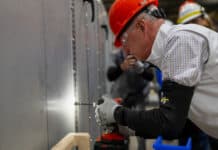More than 21,000 workers in the U.S. have been injured and 1,500 have died in workplace electrical accidents since 2008 according to the Electrical Safety Foundation International (ESFI), is a 501(c)(3) non-profit educational and training organization. In response to this grim problem, the Foundation has released updated safety training materials. These include an extensive collection of instructional videos, infographics, practical tips, plus templates and tools employers can use to promote electrical safety in the workplace.
“Sixty-four percent of all electrical fatalities on the job occur in occupations that traditionally receive little to no electrical training, such as landscapers, roofers, HVAC technicians, welders, plumbers and truck drivers,” explains ESFI president Brett Brenner. “Our goal is to help employees better understand how easily electrical safety can be incorporated into their daily routines, whether that work takes place in an office, on a job site or in a manufacturing setting.”
Brenner reports that while electrical hazards are not the leading cause of on-the-job injuries, they are disproportionately fatal and costly. The good news, he notes, is that most on-the-job electrocutions and electrical injuries can be prevented with proper training. All electrical work should be completed by qualified electrical workers.
Take Electrical Precautions For Workplace Safety
Following are some electrical safety tips from ESFI experts to remind employees how to make the work environment safer:
Before starting work
- Perform a risk assessment before starting any job.
- Ensure all electrical conductors and circuit parts are in an electrically-safe working condition.
- Gather all the necessary tools to complete a project before starting.
- Ensure that all the necessary parts of a machine are properly guarded to reduce the likelihood of electrical contact or arcing faults.
- Ask your employer for the necessary training and experience for a project to reduce the risk of injury.
Overhead power line safety
- Locate all power lines before starting any work.
- Keep yourself and your equipment at least 10 feet away from all overhead power lines.
- Never touch anything in contact with a power line.
- Be wary of any fencing near power lines, as fences can conduct electricity if they touch power lines.
- Carry ladders horizontally to reduce the risk of touching power lines.
- Do not spray water or liquid cleaners near any power lines.
- Stay 35 feet away from any fallen power lines.

Qualified Electrical Workers Crucial To Safety
Trained electrical workers know the requirements of NFPA 70, National Electrical Code, and are experienced in NFPA 70E, Standard for Electrical Safety in the Workplace. These trained workers follow strict safety principles that include daily inspections of the job site and equipment. The safety programs for a qualified electrical worker include training on personal protective equipment, safe work practices, special precautionary techniques, and risk assessment.
“Employees are the greatest value of any business, and we want to ensure everyone practices job site safety,” says EFSI’s Brenner. “Electrical danger is one of the leading causes of workplace injuries and fatalities. We want all workers to practice safety assessments and learn when to stop work to avoid becoming a statistic.”
For ESFI’s complete collection of workplace safety resources and for more information on how to use them, visit the Foundation’s website here.
ESFI was founded in 1994 as a cooperative effort by the National Electrical Manufacturers Association (NEMA), Underwriters Laboratories (UL), and the U.S. Consumer Product Safety Commission (CPSC). ESFI sponsors National Electrical Safety Month each May to increase public awareness of the electrical hazards around us at home, work, school, and play.

















![[VIDEO] Collect Asset Data at the Speed of Walking a Building](https://facilityexecutive.com/wp-content/uploads/2024/02/maxresdefault-324x160.jpg)